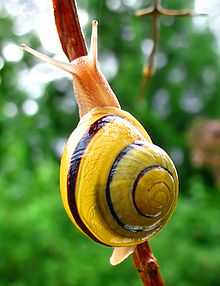White-lipped snail
| White-lipped snail | |
|---|---|
 | |
| Scientific classification | |
| Kingdom: | Animalia |
| Phylum: | Mollusca |
| Class: | Gastropoda |
| (unranked): | clade Heterobranchia clade Euthyneura |
| Superfamily: | Helicoidea |
| Family: | Helicidae |
| Genus: | Cepaea |
| Species: | C. hortensis |
| Binomial name | |
| Cepaea hortensis (O. F. Müller, 1774)[1] | |
The white-lipped snail (Cepaea hortensis) is a medium-sized species of air-breathing land snail, a terrestrial pulmonate gastropod mollusc. It is a close relative of the grove snail.
Shell description


The white-lipped snail is very slightly smaller than the grove snail, the shell being usually about 2.5 cm (1 in) in maximum dimension. Like the grove snail (brown-lipped snail), it has considerable variability in shell colour and banding, although the shell of the white-lipped snail is perhaps most commonly yellow, with or without brown banding. The principal distinguishing feature of this species is a white lip at the aperture of the shell in adult specimens, although very rarely the brown-lipped grove snail can have a white lip, and vice versa.[2]
Distribution
The native distribution of this species is Western Europe and Central Europe.[3] The range of the white-lipped snail extends closer to the Arctic in Northern Europe than the range of the grove snail. The white-lipped snail has been introduced to northeastern parts of the USA, but has not established itself as successfully as the grove snail.
Habitat
The two species share many of the same habitats, such as woods, dunes and grassland, but the white-lipped snail tolerates wetter and colder areas than the grove snail can.
Life cycle
This species of snail creates and uses love darts during mating.
The size of the egg is 2 mm.[4]
References
- ↑ Müller, O. F. 1774. Vermivm terrestrium et fluviatilium, seu animalium infusoriorum, helminthicorum, et testaceorum, non marinorum, succincta historia. Volumen alterum. - pp. I-XXVI [= 1-36], 1-214, [1-10]. Havniae & Lipsiae. (Heineck & Faber).
- ↑ Simon Whipps, July 2009; last updated July 2009. Life & Environment, University of the West of Scotland; BIODIVERSITY REFERENCE - Cepaea nemoralis and Cepaea hortensis
- ↑ Kerney M.P. & Cameron R. A. D., 1979. “A field guide to the land snails of Britain and northwestern Europe’’, Collins, London. ISBN 0-00-219676-X
- ↑ Heller J. 2001: Life History Strategies. in Barker G. M. (ed.): The biology of terrestrial molluscs. CABI Publishing, Oxon, UK, 2001, ISBN 0-85199-318-4. 1-146, cited page: 428.
External links
| Wikimedia Commons has media related to Cepaea hortensis. |
- Images of shell variations in C. hortensis
- Snail white - Images of shell variations in C. hortensis Thai language translate